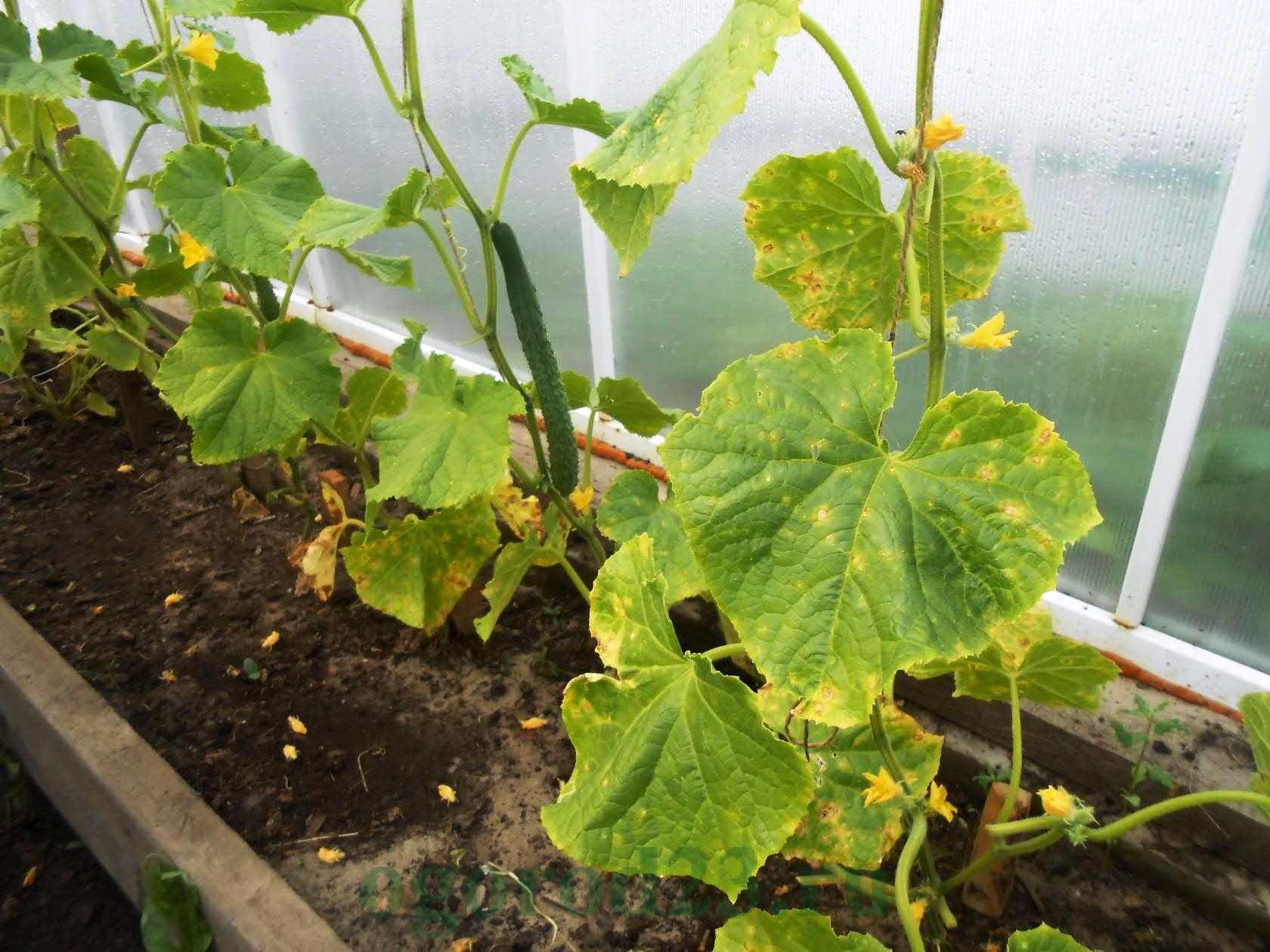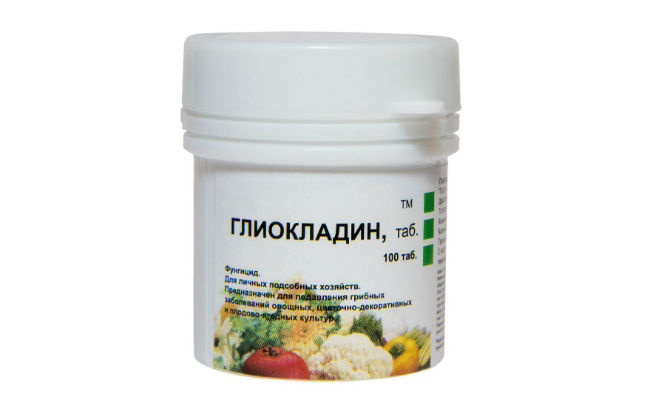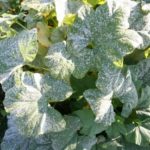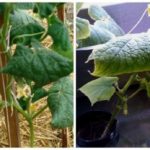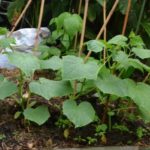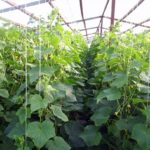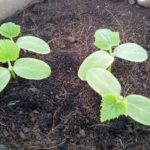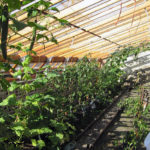One of the most common diseases of vegetables is peronosporosis of cucumbers. Treatment of this disease must be carried out immediately after its appearance. If this is not done, then over time the yield of cucumbers will decrease and the plant will die.
Description
Small yellow oily spots form on the leaves of plants that suffer from downy mildew. They are limited by veins and have a rounded shape.Over time, the lower part of the leaves becomes covered with a purple coating. Gradually, the spots on the leaves begin to increase and merge. Because of this, they dry out, wrinkle and crumble. After the leaves die off, the development and setting of cucumbers slows down, the fruits lose their former juiciness and rich taste. If left untreated, downy mildew on cucumbers can completely destroy the plant within a short period of time.
Downy mildew is a rather dangerous disease, as it can harm not only cucumbers, but also other cultivated plants. It can infect shrubs, trees, vegetables and even indoor plants. The spread of the disease is facilitated by various insect pests - aphids or whiteflies. Therefore, if these pests are noticed on cucumbers, you need to immediately take measures to eliminate them.
Reasons for appearance
For a plant to be infected with downy mildew, certain conditions must exist - warmth and high humidity. There are also other factors that contribute to its appearance and development:
- regular watering cucumbers with too cold water;
- poor ventilation system in the greenhouse;
- strong temperature changes;
- prolonged downpours, which increase air humidity;
- a large number of weeds near the plants.
In dry weather, downy mildew appears very rarely in cucumbers. It quickly attacks the plant only under favorable conditions. Quite often, because of this, another disease of cucumbers appears - bacteriosis.
Methods of protection
There are various ways to protect cucumbers from the appearance and spread of peronosporosis.
Basic recommendations
There are several basic recommendations that will help prevent downy mildew in cucumbers:
- You need to plant the seeds in places where it will be quite difficult to become infected with downy mildew. Planting should be done in areas with pre-treated soil.
- After harvesting the fruits, it is necessary to disinfect the soil and get rid of plant residues.
- During the growing season, it is necessary to monitor soil moisture.
- It is recommended to cultivate varieties with resistance to downy mildew. These include Zodiac, Debut, Idol, Fontana and Photon.
- When growing cucumbers in a greenhouse, you need to monitor the microclimate in it to avoid dripping moisture on the leaves.
- The soil must be regularly fertilized with organic and mineral substances, which increase the resistance of cucumbers to various diseases.
- If some bushes have already become infected with downy mildew, they should be destroyed immediately. This will prevent the disease from spreading to other plants.
Soil care
The area must be regularly cleared of fallen leaves in which zoospores can develop. Also, the ground must be periodically disinfected and dug to a depth of about 35-40 cm. If the bushes were infected in the previous year, then it is better to repeat the digging again in the spring.
Soil disinfection is carried out using a 1% solution of potassium permanganate and a 3% solution of copper sulfate. These mixtures must be used very carefully, as they can harm not only pathogenic, but also beneficial microflora.
In the garden, it is imperative to observe cultural rotation. The culture can be returned to its original place only after 4-5 years. If you plant cucumbers in the same place for several seasons, an accumulation of bacteria and infections may occur. This increases the likelihood of contracting peronosporosis.
Plant care
To make cucumbers more resistant to diseases, they need to be planted correctly. Before planting, you should disinfect the seeds. This can be done using heat treatment. To do this, the seeds are heated to 35-40°C for 15-20 minutes. You can treat cucumber seedlings with a weak 0.1% solution of potassium permanganate. In this case, its roots are immersed in the mixture for several hours.
During the growing season, it is necessary to monitor the spread of weeds. You also need to regularly get rid of plants that can no longer be cured of powdery mildew. They should be dug up first and then burned.
Preparations for peronosporosis
Quite effective means of combating peronosporosis are chemicals.
Acrobat MC
Used to treat and prevent disease. Acrobat MC contains two active ingredients that belong to cinnamic acid amides - dimethomorph and mancozeb. They have a local-systemic effect that protects cucumbers inside and out.
Before using the drug, it is necessary to prepare a working solution. To do this, add 50 g of Acrobat MC to 10 liters of water. The first treatment can be carried out even in the absence of signs of peronosporosis in cucumbers.
This will be an excellent preventive measure to protect the bushes from disease. The second spraying should be carried out two to three weeks after the first.
It is better to carry out the treatment in clear and windless weather, so that the drug spreads evenly on the bushes and is not sprayed onto neighboring plants.
Alirin B
It can be used to treat downy mildew and other fungal diseases. It also reduces soil toxicity after the use of hazardous chemicals and restores soil microflora.
To prepare a working solution for watering bushes, add two tablets of the drug to 10 liters of water. When spraying cucumbers, you need to use a different mixture. To prepare it, add one Alirin B tablet to each liter of water.
This drug has excellent compatibility with other products, so it can be used together with growth regulators, fungicides and insecticides.
Glyocladin
Used during the prevention of bacterial and fungal diseases. The active ingredient of the drug is the fungal culture Trichoderma. When this substance enters the disease cells, it begins to dissolve them from the inside. This blocks the further development and spread of peronosporosis.
Glyokladin is not used for spraying bushes, but for treating the soil before planting cucumbers. The drug should be placed in the upper layers of the soil, since this is where the best conditions for Trichoderma are found. When planting seeds, no more than two tablets of Glyocladin should be added to the hole. It is recommended to use gloves when working with the drug.
Oksikhom
This systemic contact fungicide is excellent for protecting cucumbers from LMR. It destroys pathogens at all stages in the shortest possible time. Oxychom contains copper oxychloride, which kills all the vital components of downy mildew cells.
To prepare a working solution in 5 liters of water, you need to add 15 g of the drug. The mixture should be applied to the bushes in sunny and calm weather. Cucumber bushes need to be sprayed at least three times per season. The interval between treatments is about 10-15 days.
Oxychome cannot be used in parallel with other products that should not come into contact with an alkaline environment.
Ordan
The drug is available in powder form, which can be sold in packages weighing from 1 to 10 kg. This product contains two active substances that can be used to get rid of peronosporosis:
- cymoxanil - with its help, the synthesis of ribonucleic acids slows down;
- copper oxychloride - disrupts the functioning of the enzymatic system.
When processing cucumbers, it is recommended to use a 0.025% solution. To prepare it, add 25 g of the drug to 10 liters of water. The bushes should be sprayed immediately after the first symptoms appear. The working solution cannot be stored for a long time, as it quickly deteriorates.
Ordan is not recommended for use with drugs that contain alkalis. It can be combined with other fungicides and pesticides. However, before mixing, their compatibility must be checked. If they are not compatible, a precipitate will appear in the solution.
Quadris
When spraying bushes, this product gets onto the leaf plate and protects it from pathogens. The main active substance of Quadris is azoxystrobin, which is used to destroy infectious agents.
For processing it is recommended to use 0.2% or 0.1% working solution. In one season you need to spray the bushes at least three times. This should be done in the evening or morning, when there is no strong wind.
Folk remedies
In addition to the use of chemicals, there are other measures to combat downy mildew on cucumbers. You can get rid of this disease in cucumbers using various folk remedies.
Soda
To prepare a soda solution, you need to add 40 g of soda and 15 ml of liquid soap to 5 liters of boiled water. All components should be thoroughly stirred until they are completely dissolved. After this, you can start spraying the soil and bushes. The procedure must be carried out 4 times per season. The interval between treatments should be about one week.
Milk
To prepare a milk solution, add 40 drops of iodine and 35 g of grated laundry soap to a liter of milk. This product should be used throughout the entire growth period of cucumbers. Spraying should be carried out regularly, every 10 days.
You can also make whey. To do this, several liters of milk are added to a bucket of water, after which the mixture is heated to a temperature of +25 degrees. The serum can be used not only to treat already infected bushes, but also healthy ones.
Onion peel
This medicine is very effective in the early stages of the disease. To prepare it, add 500 g of husk to 10 liters of water. The resulting mixture is boiled over low heat and infused for several days. It is recommended to spray cucumbers several times a month.
Conclusion
Downy mildew is a rather dangerous disease that can lead to the death of plants. You need to get rid of downy mildew on cucumbers immediately. To do this, it is enough to familiarize yourself with the most effective ways to combat it.


